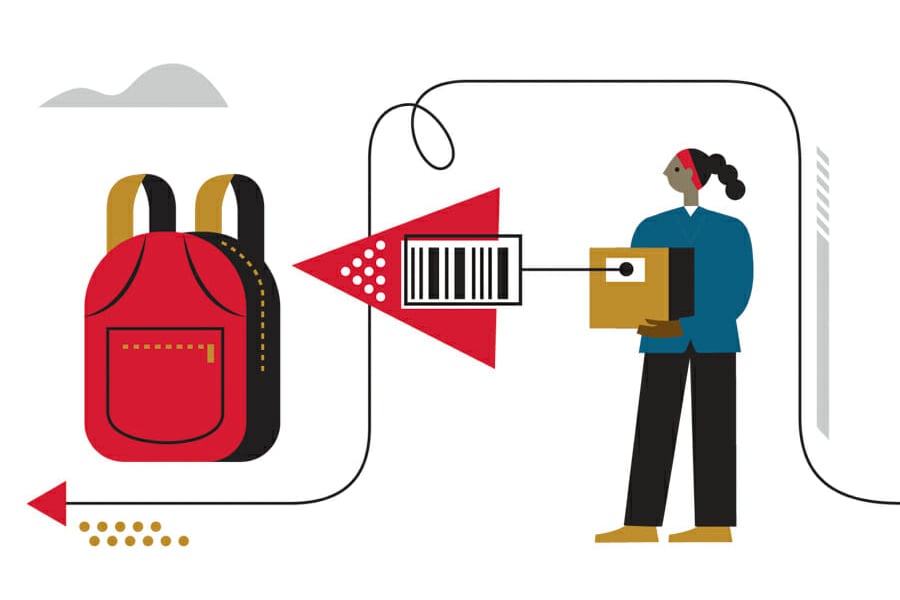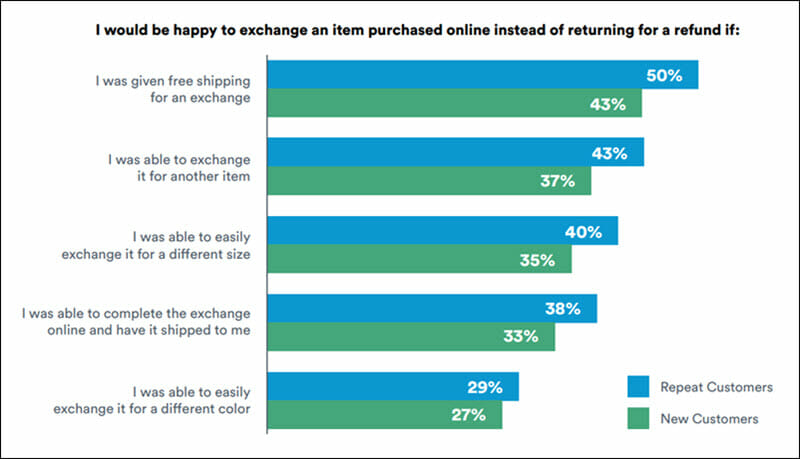Logistics
Industries
Technology & Innovations
E-commerce
E-commerce Fulfillment Services
Lease & Maintenance
Semi Trucks
Logistics
E-commerce
Lease & Maintenance
Buy Used Trucks

[Updated post from August 26, 2021]
Returns are the bane of retailers' existence. But that doesn't mean that the returns process shouldn't be as easy as possible for customers to navigate.
Thanks to seamless returns management, both brands and consumers will face greater convenience and less frustration during the post-purchase experience. Easy returns don't just increase customer satisfaction; they also increase the likelihood of customers choosing to exchange rather than return items, hence maintaining a relationship with your brand.
Despite this, 32% of customers report needing to contact the retailer to obtain a return authorization, which adds a significant barrier to shoppers being able to return or exchange items.
This is where self-service returns are a breath of fresh air to customers who just want their returns processed quickly and efficiently.
Self-service returns allow customers to complete e-commerce returns or exchanges independently, without assistance or authorization from a customer service representative. This simplifies the returns experience and makes it easier for customers to achieve their desired outcome e.g. an exchange, a store credit, or a refund.
By empowering customers with a self-service returns process, brands can deliver a truly customer-centered returns experience while easing the strain on their customer service team.
Traditionally, retailers and e-commerce brands have managed customer returns by reviewing every return request and having their customer service team determine whether or not they meet return policy guidelines.
Let's say you bought a pair of pants online and found they didn't fit. To make a return, you first need to contact the merchant to submit any return requests to obtain an RMA (Returned Merchandise Authorization). You'll need to provide information such as"
A customer service representative will consider your request and decide whether it falls within the brand's return policy. They may also check your order history to see if there's a repeat pattern that may indicate returns fraud. Once the return is approved, you'll be provided with instructions for where to send the merchandise.
Manual returns ensure that customer support teams take a gatekeeping role during the returns process to prevent fraud. According to the National Retail Federation, retailers lose $10.40 to return fraud for every $100 that gets accepted in returned merchandise. However, making customers justify their reason for returning adds a huge amount of friction to the returns experience.
When the majority of customers expect a hassle-free returns process, making shoppers jump through hoops to return items can hurt customer retention. Once customers come to know how time-consuming it is to make returns, they're unlikely to want to shop with your brand again.
In contrast to manual review returns, a self-service returns process is under the direction of your customer from beginning to end. This allows customers to be proactive and initiate returns without waiting for authorization, which helps to save time and endless chain email chains.
Great customer service is no longer defined by attentive representatives. In e-commerce, it hinges on your ability to equip customers with the tools they need to solve problems themselves.
According to Bizreport, 73% of shoppers want the ability to solve product or service problems on their own. A further 60% say they prefer using digital self-help tools to contacting a customer service representative directly.
By giving customers the support and flexibility they need to manage returns themselves, you can increase customer retention and make the returns process easier. It's worth remembering that a whopping 92% of consumers will buy from a merchant again if the returns process is easy!
Shelling out refunds is a situation that most e-commerce merchants try to avoid at all costs. But punitive return policies that forbid refunds in favor of store credits or exchanges are only going to sour customers' perception of your brand.To boost their proportion of exchanges and retain more revenue, brands need to make exchanges a convenient option. According to Narvar’s 2019 study, consumers are more likely to make exchanges rather than ask for refunds if:

A self-service return workflow that makes it easy to exchange returned items offers positive reinforcement to maintain the brand relationship, rather than ending it. Customers initiating the return can elect the products they would like to exchange and those they would like to return, rather than relying on a customer service representative who could slow down the process.
Manually vetting and approving return requests puts a huge strain on your customer support team, even during quieter parts of the year. But during peak season, this can quickly become unmanageable. As order volumes increase in the lead-up to the holidays, seasonal returns will inevitably follow.
During the post-holiday rush, having your team approve returns, generate shipping labels, and communicate return instructions for individual orders is inefficient and causes returned merchandise to pile up. Slow refunds undermine your relationship with customers, in addition to causing your brand to miss out on valuable resale opportunities.
With a self-service return workflow, you can avoid long processing times by allowing your customers to direct this process instead of your customer support team. This frees up valuable time for your team to spend handling more complex service requests.
The workflow will depend on whether the return is being completed online or in a physical store setting.
In this model, customers will head straight to the returns center on the merchant's website or via a link provided in their order confirmation email. Once at the self-service returns portal, customers can initiate the return by providing their order number and selecting which items they would like to return or exchange. The RMA will be granted and a return shipping label generated to allow customers to mail their return straightaway.
If customers have outstanding store credits, some return portals will automatically direct customers to a product catalog within the returns portal to provide product suggestions. This helps to create a closed loop where customers are redeeming store credit on fresh online purchases, retaining more revenue over time.
Although still an emerging offering within brick and mortar, self-service return drop-off locations are picking up steam. Has been powered both by the COVID-19 pandemic and efforts by retailers to reduce bottlenecks at checkouts caused by in-store returns.
By eliminating the traditional lag between returning an item and receiving a replacement product or refund, retailers can enhance the customer experience and encourage repeat purchasing behaviors.
Rent the Runway has experimented with in-store returns kiosks that offer customers a convenient return process method at partner retailers like Nordstrom. Customers just need to scan a barcode on the garment they rented and drop it into the returns bin. Kiosks are also capable of facilitating refunds either via credit card or the customer's preferred payment method.
Brands that don't have physical stores or partner retailers don't have to say goodbye to the prospect of in-store returns altogether. Ryder E-commerce integration partner Happy Returns offers merchants a network of in-store return points within convenient locations such as pharmacies or grocery stores, enabling online sellers to consolidate their returns and ship them to the warehouse with effective routing.
Your brand needs to make your self-service returns process clear from the outset. Hosting a comprehensive returns policy and FAQ page in a prominent location on your website helps to prevent confusion when customers are searching for returns information.
Not only does a well-written returns policy provide clarity to your customers; but it's also a fantastic selling point. With 49% of customers checking a merchant's return policy before purchasing, this is a clear indicator that the ease of the returns process plays a major role in meeting customer expectations.
To implement a true self-service return solution, customers need to be able to initiate a return when they decide it's necessary. If they have to reach out to your customer service team to obtain access to a self-service returns portal, this defeats the purpose of customer-centered returns.
Instead, you should make an effort to include relevant return information within the customer's order confirmation email. This is a vital touchpoint within the e-commerce experience that provides your customer with a roadmap on how to navigate the post-purchase experience, turning possible areas of friction into seamless brand interactions.
In addition to providing reassurance that their order is on its way, being transparent about the returns process increases trust and helps to minimize anxiety during the post-purchase experience.
Investing in an advanced returns management tool with automation capabilities will make it far easier to offer a robust self-service solution to your customers. Third-party return solutions give retailers an all-in-one return center, including branded return portals, one-click exchange capabilities, and advanced analytics to understand what is contributing to your return rate. Ryder E-commerce offers seamless integrations with Happy Returns, Returnly, and Loop.
To create the ultimate self-service returns solution, it's tempting to take the approach of planning for a return from the outset of order fulfillment. This involves providing a return slip and return label with outbound orders, as well as return-ready packaging if needed.
Automatic returns are a common strategy amongst fast-fashion retailers whose revenue model requires high volumes of sales, but who can't process a corresponding number of return requests.
While this is extremely convenient for your customers and will increase customer satisfaction, this approach does have some downsides. If customers don't need to submit return requests, it's difficult to prepare for a spike in return activity ahead of time. Moreover, customers may provide scant information on their return reasons – or none at all – making it impossible to identify issues that are driving returns.
Just because your customer placed an order online doesn't mean that's how they want to return their purchase. In fact, 79% of consumers try to avoid mail-in returns whenever possible due to the lack of convenience and longer time to get a refund.
Giving your customers the choice to return items in-store not only streamlines the return process but also increases the likelihood they will buy replacement items during the same store visit. The benefit of in-store returns for retailers is that the returned merchandise is immediately available for resale from the store outlet, or can be sent back to the warehouse to fulfill online orders.
With the right prompt or incentive, lost revenue can be transformed into retained revenue. It's worth noting that customers prefer to make exchanges more often than brands might think; nearly two-thirds of consumers plan on exchanging or finding a replacement for an item they've returned, either via the same retailer or a competitor.
Relevant suggestions for product replacements, the ability to earn additional store credit, and the ability to shop for new items within the return workflow are all ways to make exchanging products easy and seamless for your customers.
By offering self-service returns, brands can streamline their returns process while still making the most of a valuable post-purchase touchpoint. Instead of simply waving a customer goodbye, a self-service returns workflow allows you to extend the customer relationship into repeat purchases. Empowering customers to manage returns themselves encourages them to interact with your brand on their terms, which increases trust and brand loyalty.